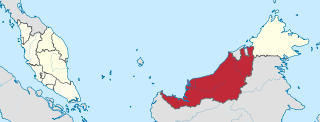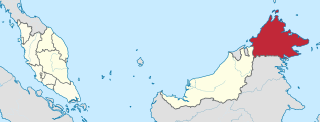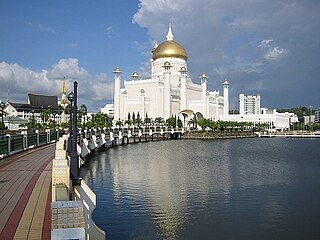
Brunei, formally Brunei Darussalam, is a country located on the north coast of the island of Borneo in Southeast Asia. Apart from its South China Sea coast, it is completely surrounded by the Malaysian state of Sarawak. It is separated into two parts by the Sarawak district of Limbang. Brunei is the only sovereign state entirely on Borneo; the remainder of the island is divided between Malaysia and Indonesia. As of 2020, its population was 460,345, of whom about 100,000 live in the capital and largest city, Bandar Seri Begawan. The government is an absolute monarchy ruled by its Sultan, entitled the Yang di-Pertuan, and implements a combination of English common law and sharia law, as well as general Islamic practices.

Sarawak is a state within Malaysia. The largest among the 13 states, with an area almost equal to that of Peninsular Malaysia, Sarawak is located in northwest Borneo Island, and is bordered by the Malaysian state of Sabah to the northeast, Kalimantan to the south, and Brunei in the north. The capital city, Kuching, is the largest city in Sarawak, the economic centre of the state, and the seat of the Sarawak state government. Other cities and towns in Sarawak include Miri, Sibu, and Bintulu. As of the 2020 census, the population of Sarawak was estimated over 2,907,500. Sarawak has an equatorial climate with tropical rainforests and abundant animal and plant species. It has several prominent cave systems at Gunung Mulu National Park. Rajang River is the longest river in Malaysia; Bakun Dam, one of the largest dams in Southeast Asia, is located on one of its tributaries, the Balui River. Mount Murud is the highest point in Sarawak.

Sabah is a state of Malaysia located on the northern portion of Borneo, in the region of East Malaysia. Sabah has land borders with the Malaysian state of Sarawak to the southwest and Indonesia's North Kalimantan province to the south. The Federal Territory of Labuan is an island just off the Sabah coast. Sabah shares maritime borders with Vietnam to the west and the Philippines to the north and east. Kota Kinabalu is the state capital city, the economic centre of the state, and the seat of the Sabah state government. Other major towns in Sabah include Sandakan and Tawau. The 2015 census recorded a population of 3,543,500 in the state, and in 2019 it was estimated to have grown to over 3.9 million. Sabah has an equatorial climate with tropical rainforests and abundant animal and plant species. The state has long mountain ranges on the west side which forms part of the Crocker Range National Park. Kinabatangan River, the second longest river in Malaysia runs through Sabah, and Mount Kinabalu is the highest point of Sabah as well as of Malaysia.

Music of Malaysia is the generic term for music that has been created in various genres in Malaysia. A great variety of genres in Malaysian music reflects the specific cultural groups within multiethnic Malaysian society: Malay, Chinese, Indian, Dayak, Kadazan-Dusun, Bajau, Orang Asli, Melanau, Kristang and others.
Brunei is a southeast Asian country located on Borneo between the states of Sabah and Sarawak which are part of Malaysia. There is a wide array of native folk music, and dance. Brunei shares some Cultural perspectives and links with the countries of South East Asia such as Malaysia, Singapore, Indonesia, Thailand, Philippines. The strong Islamic influence means that dance performances and music are somewhat restricted.

Dusun is the collective name of a tribe or ethnic and linguistic group in the Malaysian state of Sabah of North Borneo. Collectively, they form the largest ethnic group in Sabah. Dusun has been recognised as among the indigenous community of Borneo, with documented heritage by the United Nations Educational, Scientific and Cultural Organization (UNESCO) since 2004.

The culture of Malaysia draws on the varied cultures of the different people of Malaysia. The first people to live in the area were indigenous tribes that still remain; they were followed by the Malays, who moved there from mainland Asia in ancient times. Chinese and Indian cultural influences made their mark when trade began with those countries, and increased with immigration to Malaysia. Other cultures that heavily influenced that of Malaysia include Persian, Arabic, British. The many different ethnicities that currently exist in Malaysia have their own unique and distinctive cultural identities, with some crossover.

The Murut are an indigenous ethnic group, comprising 29 sub-ethnic groups inhabiting the northern inland regions of Borneo. The Murutic languages are a family of half a dozen closely related Austronesian languages. The Murut can be found mainly in Sabah, Malaysia including in Sarawak, Malaysia, Brunei, and Kalimantan, Indonesia.

The Sama-Bajau refers to several Austronesian ethnic groups of Maritime Southeast Asia. The name collectively refers to related people who usually call themselves the Sama or Samah ; or are known by the exonym Bajau. They usually live a seaborne lifestyle and use small wooden sailing vessels such as the perahu, djenging (balutu), lepa, and vinta (pilang). Some Sama-Bajau groups native to Sabah are also known for their traditional horse culture.

Kadazan-Dusun also less-known as "Mamasok Sabah" are two indigenous peoples of Sabah, Malaysia—the ethnic groups Kadazan and Dusun. The Kadazandusun is the largest native group of Bumiputra in Sabah. They are also known as "Mamasok", which means "originals" or "indigenous people", respectively. Most of the Kadazan-Dusun tribes believed they are descendants of Nunuk Ragang people. Kadazan-Dusun has been recognised as an indigenous nation of Borneo with documented heritage by the United Nations Educational, Scientific and Cultural Organization (UNESCO) since 2004. Kadazan-Dusun is also recognised as a bumiputera group in Sabah that has its own special rights from land rights, rivers, to maintaining customs.

Limbang Division is one of the twelve administrative divisions of Sarawak, Malaysia. It has a total area of 7,788.50 square kilometres, and is the fourth largest division after Kapit Division, Miri Division and Bintulu Division. Limbang Division consists of two districts which are Limbang District and Lawas District, which in turn are divided as sub-districts in Limbang and two sub-districts in Lawas. Long Semadoh and Ba’kelalan are rural settlements in the southern part of Lawas district. Two major towns in Limbang are Limbang and Lawas. There are also few smaller towns such as Sundar, Trusan, Merapok and Tedungan.

Malaysian Malays are Malaysians of Malay ethnicity whose ancestry originates wholly or partly in the Malay world. In 2015 population estimate, with the total population of 15.7 million, Malaysian Malays form 50.8% of Malaysia's demographics, the largest ethnic group in the country. They can be broadly classified into two main categories; Anak Jati and Anak Dagang.

Pangalay is the traditional "fingernail" dance of the Tausūg people of the Sulu Archipelago and eastern coast Bajau of Sabah.

The demographic features of Brunei include population density, ethnicity, education level, health of the populace, economic status, religious affiliations and other aspects of the population. Like neighbouring countries, Brunei is a Malay-dominated country. Many cultural and linguistic differences make Brunei Malays distinct from the larger Malay populations in nearby Malaysia and Indonesia, even though they are ethnically related and share the Muslim religion.

Bruneian Malays are a native Malay ethnic group that lives in Brunei, the federal territory of Labuan, the southwestern coast of Sabah and the northern parts of Sarawak. The Bruneian Malays are a subgroup of the larger ethnic Malay population found in the other parts of the Malay World, namely Peninsular Malaysia and the central and southern areas of Sarawak including neighbouring lands such as Singapore, Indonesia and Southern Thailand, having visible differences especially in language and culture, even though they are ethnically related to each other and follow the teachings of Islam. All Bruneian Malays who are born or domiciled in East Malaysia even for generations before or after the independence of the states of Sabah and Sarawak from the British Empire through the formation of Malaysia in 1963 are also considered Malaysian Malays in the national census and were in the same status like the Malaysian Malays domiciled in Peninsular Malaysian states and the central and southern parts of Sarawak. They are also defined as a part of the Bumiputera racial classification together as a subgroup within the Malaysian Malay ethnic population along with the Kadazan-Dusuns, Ibans, Malaccan Portuguese and the Malaysian Siamese.
Sarawak's population is very diverse, comprising many races and ethnic groups. Sarawak has more than 40 sub-ethnic groups, each with its own distinct language, culture and lifestyle. This makes Sarawak demography very distinct and unique compared to its Peninsular counterpart.

Pinjaram, also known as penyaram, kuih UFO or kuih telinga tikus is a traditional kuih for the Bajau as well for the Bruneian Malay people in Brunei and in the state of Sabah in Malaysia.

Kelupis is a traditional kuih for the Bruneian Malay people in the country of Brunei and in the states of Sabah and Sarawak in Malaysia. It is also a traditional snack for the Bisaya people as the three ethnics are ethnically related which is Lun Bawang/Lundayeh also create this kelupis especially on the wedding ceremony.

Tourism in Brunei is governed by the Ministry of Primary Resources and Tourism, which is planning to diversify Brunei's tourism to include adventure tourism, ecotourism and Islamic tourism.

Traditional Malaysian art is primarily composed of Malay art and Bornean art, is very similar with the other styles from Southeast Asia, such as Bruneian, Indonesian and Singaporean. Art has a long tradition in Malaysia, with Malay art that dating back to the Malay sultanates, has always been influenced by Chinese, Indian and Islamic arts, and also present, due to large population of Chinese and Indian in today's Malaysian demographics.

















